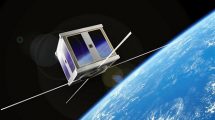 A 28-year-old Ugandan scientist made the news with his satellite that he’s building in his mother’s backyard. Chris Nsamba, who founded the African Space Research Program in 2009, is working with a handful of student volunteers to build and launch Uganda’s first space observer. The probe, equipped with solar panels and a camera, is to make its maiden voyage with a live rat as its sole passenger. As basic as this set-up sounds, it’s still a milestone not only for the country but its universities as well. There is a strong link between universities and satellite industry successes.
A 28-year-old Ugandan scientist made the news with his satellite that he’s building in his mother’s backyard. Chris Nsamba, who founded the African Space Research Program in 2009, is working with a handful of student volunteers to build and launch Uganda’s first space observer. The probe, equipped with solar panels and a camera, is to make its maiden voyage with a live rat as its sole passenger. As basic as this set-up sounds, it’s still a milestone not only for the country but its universities as well. There is a strong link between universities and satellite industry successes.
Space technology start-ups often emerge from university projects. Skybox Imaging is one such example. It started out as an assignment from a technology entrepreneurship class at Stanford University. Today, it’s a USD 91-million company that intends to deploy a 24-Pico-satellite cloud by 2018 that will scour the globe for information capable of an industrial revolution. Hedge funds, for example, could follow the ship to predict where the price of oil is going while governments could use it during times of calamity. How much devastation could be reduced if bodies used hourly snapshots of disaster-stricken areas to identify collapsed roads after an earthquake, or to determine how quickly a forest fire is spreading?
Universities have played a major role in the research and development of space technology. Many international tertiary-level institutions have government-funded, specialised space research projects and programmes, and a lot offer Masters and PhDs in the field of space technology. One such MSc programme in space science and technology, also known as “Space Masters”, is funded by the European Union, which offers scholarships to students from all over the world. The main aim of the course, which is conducted by six top European universities, is to develop manpower for the ever-increasing demand of the space industry and to conduct government-funded research projects within the universities.
Some universities have also been able to produce and launch their own CubeSats, which are Pico-satellites that weigh up to 1kg and have 10cm-cubed dimension. They’re usually launched as piggyback satellites and meant for scientific and technology demonstration purposes. So far, international universities have demonstrated technologies such as testing novel communication links between a ground station and satellite, testing different communication protocols to increase data rates, earth-imaging using mobile phone cameras, earthquake monitoring, weather monitoring, attitude determination algorithms, solar array performance, radiation monitoring and star constellation mappings. All CubeSat missions to-date have had technological objectives; they either demonstrated devices and system architectures that were developed in-house, or demonstrated non-space-rated commercial-off-the-shelf (COTS) component performances.
It is evident that universities play a crucial role in the advancement of a country’s space technology. Therefore, it is vital that universities across the Middle East are progressive and offer the best in space-related courses and programmes. Not only does this contribute to regional advancements, but it sets a “home-grown” precedent; a country can depend on local universities to supply manpower and develop locally-produced technology using local recourses. From sustainability to security, depending less to as little as possible on foreign countries for satellite technology is highly beneficial.
Middle Eastern universities ought to focus on CubeSats as they are a great way for students to participate and contribute their research skills towards space technology. And who knows what can happen under the right circumstances? Students could start off by developing a simple transceiver and next thing, they could be developing a complete communication satellite with components developed entirely in-house. What a significant achievement!
While Nsamba’s project and plans seem rudimentary, the most important thing is that they’re 100% home-grown. He is effectively building the best foundation for a sustainable space programme. It would be hugely beneficial for the Middle East to follow this example.












Add Comment